I once lost a full load of equipment because I picked the wrong trailer. Wind tore off the tarp, gear bounced everywhere, and I still shook my head thinking about it.
That was years ago. Since then, I’ve been helping businesses—and everyday drivers—pick the right trailer for the right haul.
You don’t have to make the mistakes I made. You’re here because you want the facts—and I’ve got them.
In this article, I’ll break down 11 types of cargo trailers. You’ll learn what each is best for, what to avoid, and which industries use them.
By the end, you’ll have a clear picture of which trailer suits your job. No more guessing. No more mistakes.
Let’s start!
Comparison Table
Here’s a quick, easy-to-read comparison table giving you a clear glimpse of each trailer type before jumping into the detailed breakdowns
| Trailer Type | Best For | Key Features | Pros | Cons |
| Utility Trailer | Light equipment, ATVs, moving jobs | Open deck, side rails, ramp, tie-downs | Simple, affordable, versatile | No weather protection, limited capacity |
| Flatbed Trailer | Heavy machinery, oversized loads | Open platform, long deck, side access | Large loads, easy loading, open access | No cover, needs secure tie-downs |
| Gooseneck Trailer | Farm and construction equipment | Gooseneck hitch, stable, high capacity | Stable, high capacity, tighter turns | Requires pickup with special hitch |
| Refrigerated Trailer | Cold chain goods (food, pharma) | Refrigeration unit, insulated walls | Maintains temperature, protects cargo | Higher cost, needs fuel and cleaning |
| Drop Deck Trailer | Tall machines or stacked loads | Two deck levels, low deck height | Carries tall loads, safe loading | Longer, harder to reverse |
| Tilt Trailer | Quick equipment loading | Tilting bed, hydraulic/gravity tilt | No ramps, fast, good for machines | Expensive, moving parts need care |
| Container Trailer | Shipping containers | Twist locks, steel frame, adjustable | Strong, low maintenance, container-ready | Not for loose goods, needs crane |
| Dump Trailer | Loose materials (gravel, dirt) | Hydraulic lift bed, tall side walls | Fast dumping, strong build, saves labor | Heavy, costly, needs upkeep |
| Enclosed Trailer | Protected transport for tools, gear | Fully enclosed, locking doors | Weather protection, secure, organized | Heavier, costs more, height limits |
| Dry Van Trailer | Dry packaged goods | Fully enclosed, no cooling | Dry storage, easy dock loading | No temp control, not for perishables |
| Lowbed Trailer | Tall and heavy construction gear | Dropped deck, detachable neck | Handles extreme weight, allows tall gear | Heavy, costly, needs planning |
Now—let’s dig deeper into each trailer type!
1. Utility Trailers
Utility trailers are some of the most common trailers on the road. I started with one when I was just getting into hauling. Simple, open, and easy to hook up.
They’re built with a flat deck, short side rails, and no roof. You can throw just about anything on them—as long as it’s strapped down.
Key Features
- Open Deck: Gives full access from all sides, making loading and unloading fast—but offers no protection from weather.
- Side Rails: Low rails keep your gear in place and give you something to strap cargo to.
- Ramp or Rear Gate: Many models come with a fold-down ramp, perfect for rolling on equipment like mowers or ATVs.
- Single or Tandem Axle: Single axles are easier to maneuver, while tandem axles carry more weight and handle bumps better.
- Tie-Down Hooks: Built-in anchor points let you secure loads quickly with straps or bungees.
Best Used For
- Lawn Equipment: Easy to load trimmers, blowers, and mowers—especially with a ramp gate.
- ATVs and Bikes: Just roll them up and strap them down. Quick and simple.
- Construction Supplies: Carry lumber, cement bags, and tools to job sites with no hassle.
- Furniture and Moving Jobs: Great for couches, beds, and other bulky items—just cover them if rain’s in the forecast.
Pros and Cons
Pros:
- Simple to operate
- Budget-friendly
- Versatile for many small jobs
Cons:
- No protection from weather or theft
- Lower weight capacity
- Needs proper tie-downs every trip
I once hauled a bunch of plywood without covering it. That night, it rained—and I lost the whole load.
So, think about what you’re hauling. For short, light-duty work and utility trailers are a solid starting point.
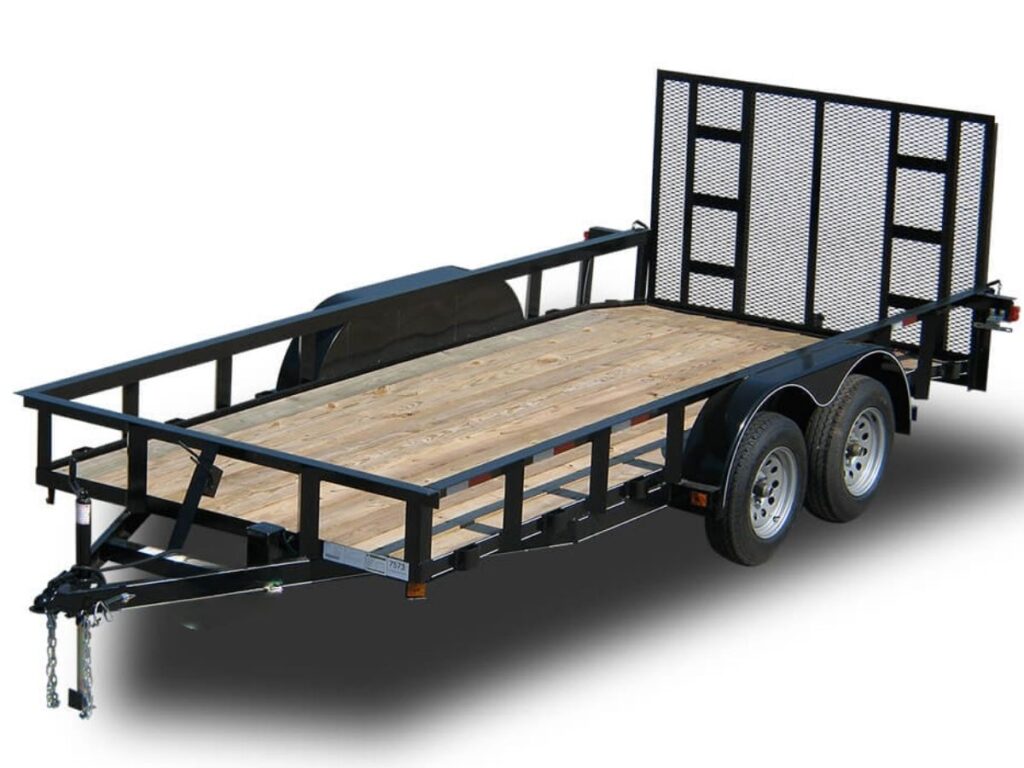
2. Flatbed Trailers
Flatbed trailers are made for heavy and oversized loads. They’re reliable, open, and built for jobs that enclosed trailers just can’t handle.
No walls. No roof. That open design allows for fast loading from any side. Forklifts, cranes, and team lifts all work well here. It’s a favorite among construction, agriculture, and industrial teams.
These trailers are all about space and strength.
Key Features
- Open Platform: Allows full side, rear, and overhead access. Best for large, awkwardly shaped cargo.
- Steel or Aluminum Deck: Built for durability. Handles high weight loads without flexing.
- Standard Lengths (48–53 ft): Supports long materials or multiple items on a single run.
- Stake Pockets and Winches: Built-in tie-down points for chains, straps, and load binders.
- Side and Rear Access: Simplifies loading with machines or manual labor.
Best Used For
- Construction Materials: Beams, wood, and piping load quickly and stack easily.
- Heavy Machinery: Skid steers, excavators, and tractors chain down securely.
- Oversized Freight: Ideal for tall or wide cargo that won’t fit enclosed.
- Pallet Loads: Great for forklift operations needing quick access.
Pros and Cons
Pros:
- Easy loading from any direction
- Supports large, heavy, or odd-shaped loads
- Quick visual checks while in transit
Cons:
- No weather or theft protection
- Load must be tightly secured
- Not ideal for loose or lightweight goods
One haul involved HVAC units on a rainy day. Even with tarps, water seeped in. Flatbeds need prep for bad weather.
Flatbed trailers work best where space, weight, and access matter more than coverage.
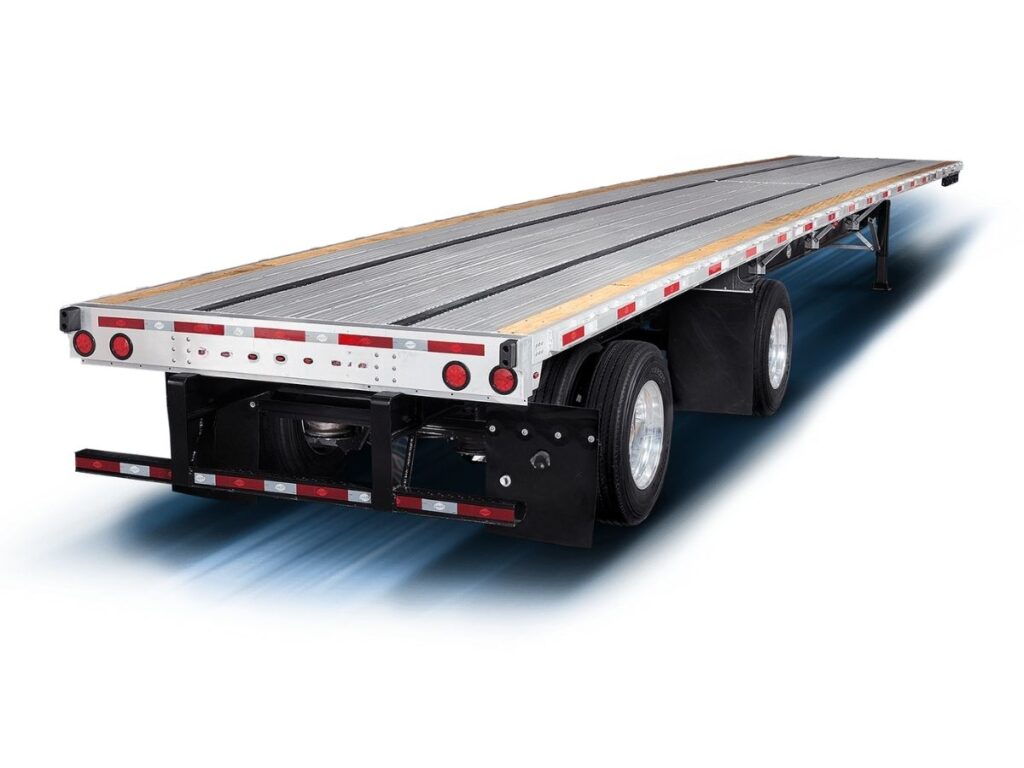
3. Gooseneck Trailers
Gooseneck trailers offer serious hauling power. I first used one to move a small bulldozer, and I could feel the difference right away. It felt stable—even on uneven roads. That curved neck design hooks into a ball in the bed of a pickup, not the bumper. That gives it better balance and tighter turns.
These trailers are built for heavy-duty work. Farmers, contractors, and equipment haulers often rely on them. When bumper pulls start to sway or bounce, a gooseneck stays solid.
Key Features
- Gooseneck Hitch: Connects over the rear axle in a pickup bed. Offers better weight distribution and less sway.
- Extended Front Arm: The neck shape adds space for toolboxes or storage.
- Heavier Load Capacity: Designed to carry more than bumper-pull trailers.
- Dual Axle Options: Many come with tandem or triple axles for big loads.
- Wide Deck Space: Supports large machinery, hay bales, or multiple pallets.
Best Used For
- Farm Equipment: Tractors, seeders, and hay—all fit well and ride stable.
- Heavy Construction Tools: Great for skid steers, small loaders, or concrete mixers.
- Livestock Transport: With the right trailer body, it’s perfect for cattle or horses.
- Bulk Deliveries: Hauls multiple pallets or stacked goods with ease.
Pros and Cons
Pros:
- Excellent stability and control
- Can carry heavier loads than many other trailers
- Handles tight turns better
Cons:
- Requires a pickup with a gooseneck hitch
- Not as quick to hook up as bumper-pull trailers
- Higher cost than basic utility models
I remember lending mine to a neighbor who never used one before. Took him longer to hitch up, but he came back amazed at how well it pulled.
So, if hauling heavy gear is part of the job, gooseneck trailers are worth considering. Strong, steady, and ready for serious work.
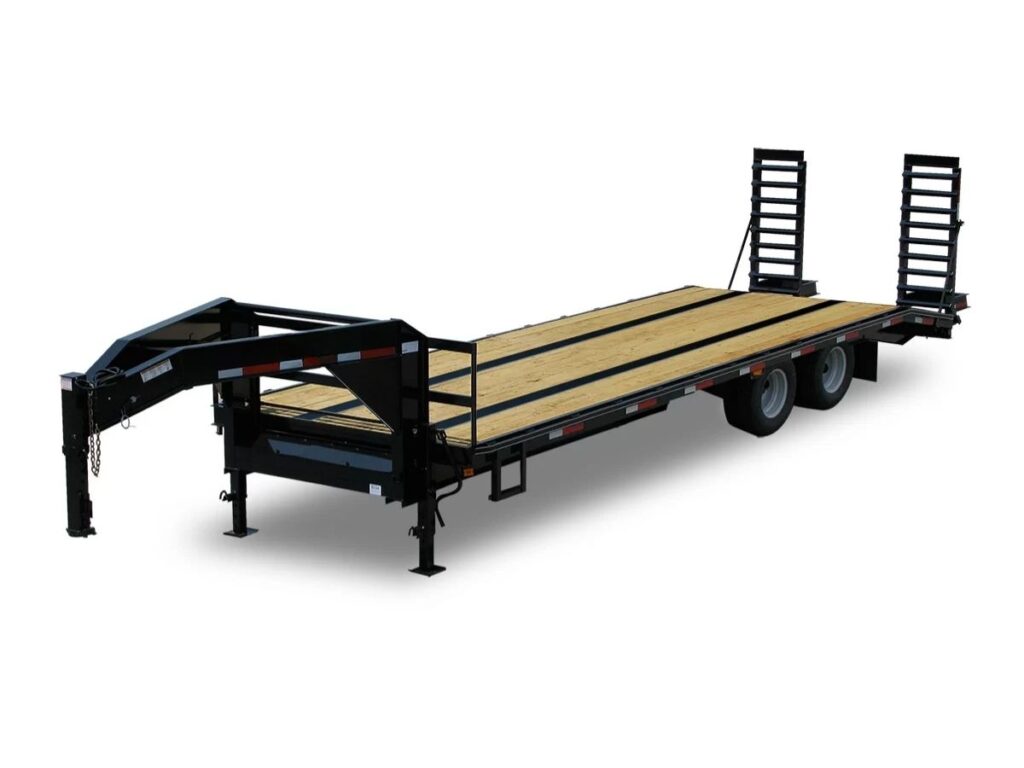
4. Refrigerated Trailers
Refrigerated trailers—also, also called reefers—are built to keep things cold. These trailers have built-in cooling units. They’re insulated and sealed to hold a set temperature. That makes them perfect for hauling anything that needs to stay cold or frozen. Some even have heat settings for temperature-sensitive goods in winter.
Key Features
- Refrigeration Unit: Mounted on the front, this system keeps the trailer cool during transport.
- Insulated Walls and Floor: Keeps cold air in and warm air out, helping maintain the right temperature.
- Temperature Controls: Settings can be adjusted for chilled or frozen goods.
- Sealed Interior: Helps prevent outside air and moisture from getting in.
- Smooth Interior Walls: Easier to clean—important for food and medical hauls.
Best Used For
- Fresh Produce: Keeps fruits and vegetables cool during long trips.
- Dairy and Meat Products: Holds cold temps to stop spoilage.
- Frozen Goods: Great for ice cream, frozen meals, or seafood.
- Pharmaceuticals: Transports medicine and vaccines safely under temperature control.
Pros and Cons
Pros:
- Maintains cold or frozen temps
- Protects sensitive products from spoilage
- Works year-round, even in heat
Cons:
- More expensive to buy and run
- Requires regular fuel or power for cooling
- Needs extra cleaning and maintenance
If temperature matters, nothing replaces a refrigerated trailer. It’s the go-to for food, medicine, and anything that can’t afford to go bad. If you’re looking for the best refrigerated trailer that will surely keep your cargo fresh and secure even in the toughest climates, Rhinotrail delivers unmatched performance and durability.
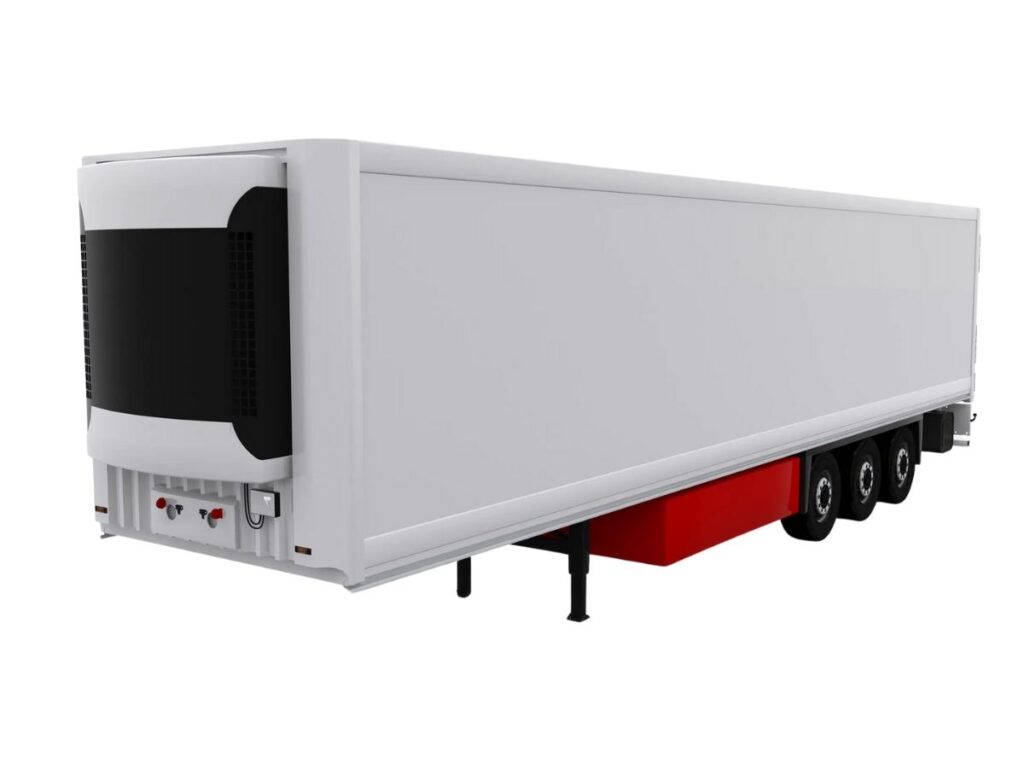
5. Drop Deck Trailers
Drop deck trailers—also called step decks—are a smart option when hauling tall or bulky items. I used one to move a large tank once. It wouldn’t fit on a regular flatbed without hitting height limits. A drop deck solved the problem.
These trailers have two levels: an upper deck near the front and a lower deck that stretches to the back. That lower deck gives extra clearance for taller loads. No special permits needed if it stays under legal height.
They’re strong and easy to load, especially when height is an issue.
Key Features
- Two Deck Levels: The front deck is higher; the back deck is lower for taller cargo.
- Lower Height Clearance: Helps carry tall equipment without going over road height limits.
- Heavy-Duty Frame: Handles heavy loads just like a flatbed.
- No Roof or Sides: Like flatbeds, cargo must be strapped down tight.
- Ramps Optional: Some models include loading ramps for rolling machinery on and off.
Best Used For
- Tall Machinery: Excavators, lifts, and other high-profile machines.
- Steel Coils and Pipes: Longer and taller loads fit better on the lower deck.
- Containers and Crates: Especially when stacked above normal height.
- Oversized Freight: That would be too tall for a regular flatbed.
Pros and Cons
Pros:
- Extra height space for taller items
- No need for extra permits in most cases
- Safer loading for large equipment
Cons:
- No weather or theft protection
- Load must be secured with care
- Can be harder to back up due to extra length
So if height is the issue, drop deck trailers are a smart and practical choice.
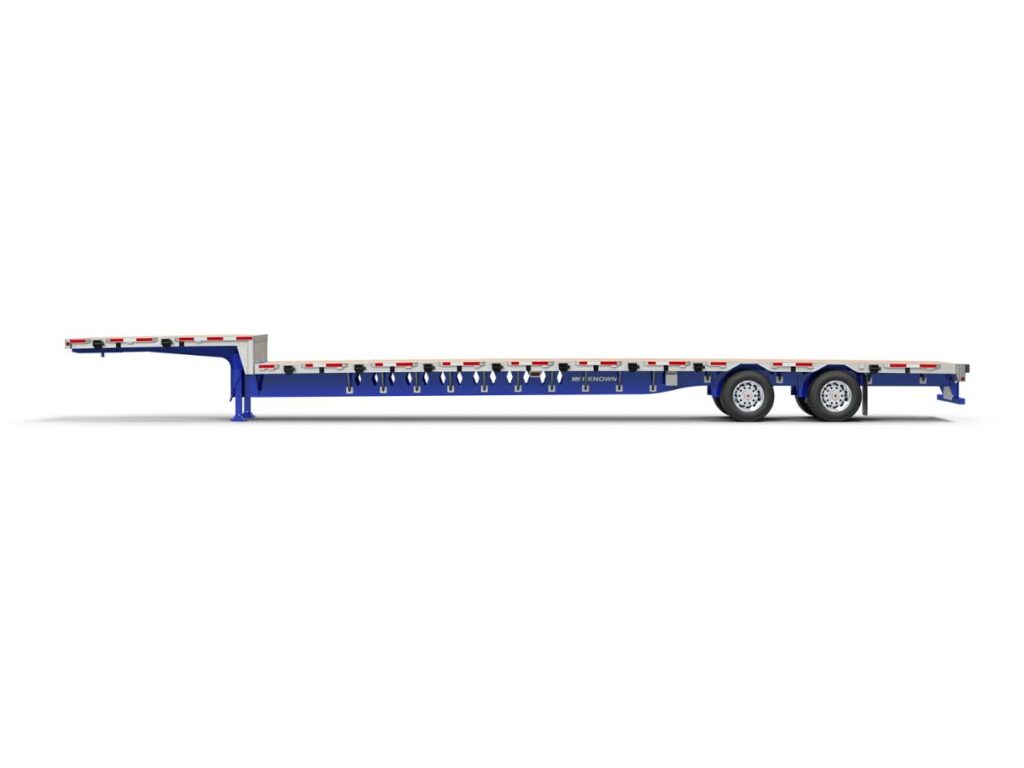
6. Tilt Trailers
Tilt trailers are built for quick and easy loading. I’ve talked with plenty of equipment haulers who won’t use anything else. The tilting bed cuts out the need for ramps. That means less time setting up and less risk of accidents.
These trailers are smart for loading wheeled or tracked machines. The bed tilts down, the load goes on, and then it levels itself back into place. Simple.
Some models tilt automatically using hydraulics. Others tilt by weight when the cargo starts rolling on.
Key Features
- Tilting Deck: The bed lowers to create a ramp without extra parts.
- Hydraulic or Gravity Tilt: Hydraulic systems add control; gravity tilt is simpler and costs less.
- Open Flat Surface: No walls or roof—makes loading from all sides easier.
- Low Deck Height: Helps reduce the angle, making loading smoother.
- Heavy-Duty Build: Most are made of steel and built to handle rough use.
Best Used For
- Skid Steers and Mini Loaders: Drive on and off without ramps.
- ATVs, UTVs, and Lawn Equipment: Smooth for weekend jobs or commercial work.
- Forklift-Loaded Gear: Fast for moving pallets and heavy crates.
- Daily Equipment Transport: Ideal for contractors moving between job sites.
Pros and Cons
Pros:
- Fast, simple loading
- No need for extra ramps
- Great for small equipment
Cons:
- Higher cost than basic utility trailers
- More parts to maintain
- Not ideal for tall or fragile cargo
Tilt trailers work best when time, safety, and smooth loading matter. They’re a solid upgrade for busy haulers.
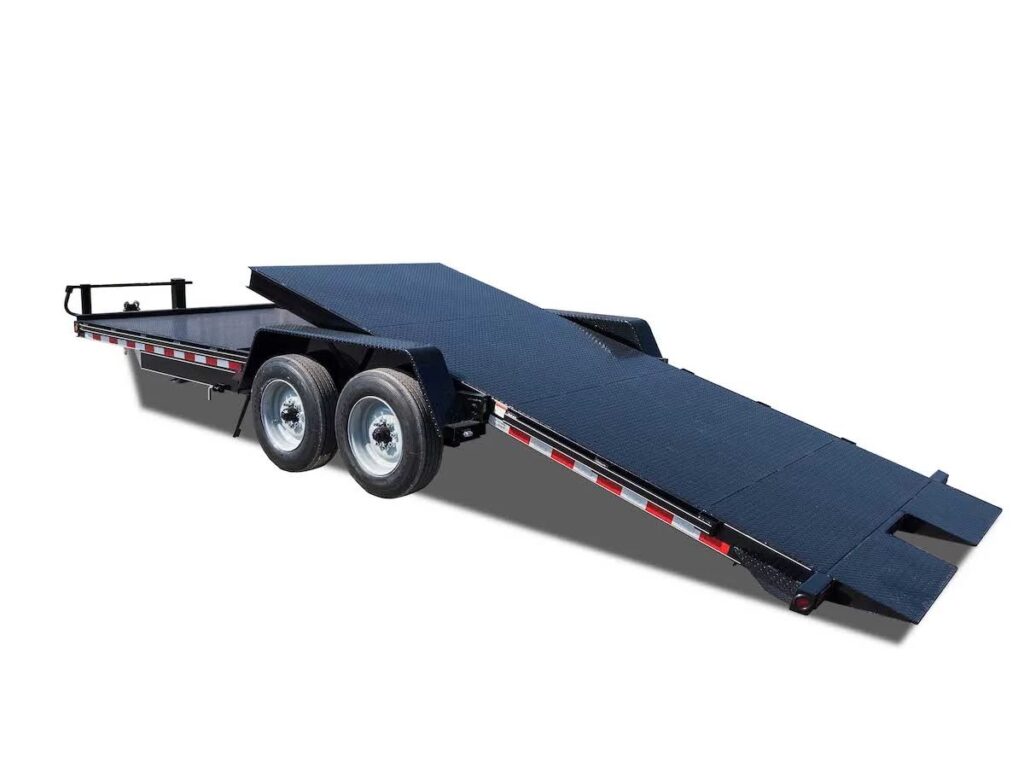
7. Container Trailers
Container trailers—also, also called container chassis—are, are made to carry shipping containers. I’ve worked with logistics teams who use them every day at ports and warehouses. They’re simple, strong, and made for one job: moving containers safely and efficiently.
Instead of a full flatbed, these trailers have a steel frame with locks to hold the container in place. That keeps the load secure during transport. Some are fixed-length, while others can adjust to fit 20-foot, 40-foot, or even longer containers.
They’re not flashy, but they’re essential in global shipping and freight.
Key Features
- Twist Locks: These hold the container tightly to the trailer frame.
- Steel Frame Design: Built strong to carry heavy container loads.
- Adjustable Lengths: Some models expand to fit different container sizes.
- Low-Deck Profile: Keeps the load height legal, even with tall containers.
- No Side Rails or Roof: Designed only for container transport—nothing else.
Best Used For
- Port-to-Warehouse Transfers: Quick moves from dock to storage.
- Intermodal Shipping: Transfers between rail, road, and sea.
- Bulk Freight: Everything from electronics to clothing packed inside containers.
- Export/Import Jobs: Essential for moving goods across countries and continents.
Pros and Cons
Pros:
- Made specifically for container hauling
- Strong, low-maintenance design
- Works well with cranes and forklifts
Cons:
- Only useful for container transport
- No flexibility for other cargo types
- Needs equipment to load and unload
I’ve heard drivers say, “It’s the easiest trailer to hook and haul—but only if you’re hauling containers.”
Container trailers are a must if you’re moving freight in boxes. Simple, tough, and built for the global shipping game.
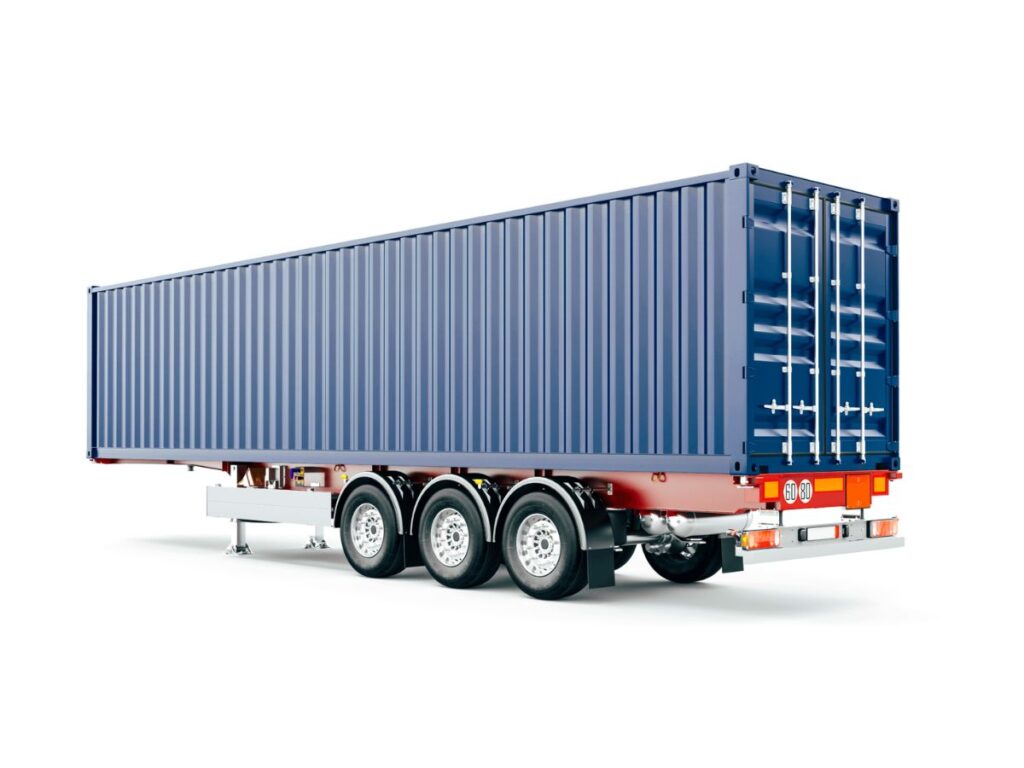
8. Dump Trailers
Dump trailers are built for tough, messy jobs. These trailers make hauling and unloading loose material faster, cleaner, and way less tiring.
Instead of shoveling out gravel, dirt, or scrap by hand, the trailer does the work. A hydraulic system lifts the bed, and everything slides out the back. It saves time and reduces physical strain, especially on busy job sites.
Some models are small and perfect for home landscaping. Others are large enough for commercial use. Either way, they’re known for getting the job done.
Key Features
- Hydraulic Lift Bed: Tilts up to dump the load without manual labor.
- Steel or Aluminum Build: Tough enough to carry rough materials like rock or scrap.
- Tall Side Walls: Keeps large or loose materials contained during transit.
- Rear Gate Options: Swing gates or barn doors, depending on how material needs to unload.
- Electric Control Box: Push-button control makes dumping easy and fast.
Best Used For
- Gravel and Sand: Quickly drops loads where needed.
- Construction Waste: Moves bricks, drywall, and scrap with ease.
- Landscaping Jobs: Delivers mulch, dirt, or stone without a mess.
- Farming Tasks: Transports compost, feed, or manure safely.
Pros and Cons
Pros:
- Saves time during unloading
- Handles heavy, dirty loads
- Reduces need for manual labor
Cons:
- Heavier than standard trailers
- More expensive upfront
- Needs regular maintenance on moving parts
If the work involves dirt, debris, or bulk loads, a dump trailer can turn a long, exhausting task into a quicker, safer, and more efficient job—saving both time and energy every single day.
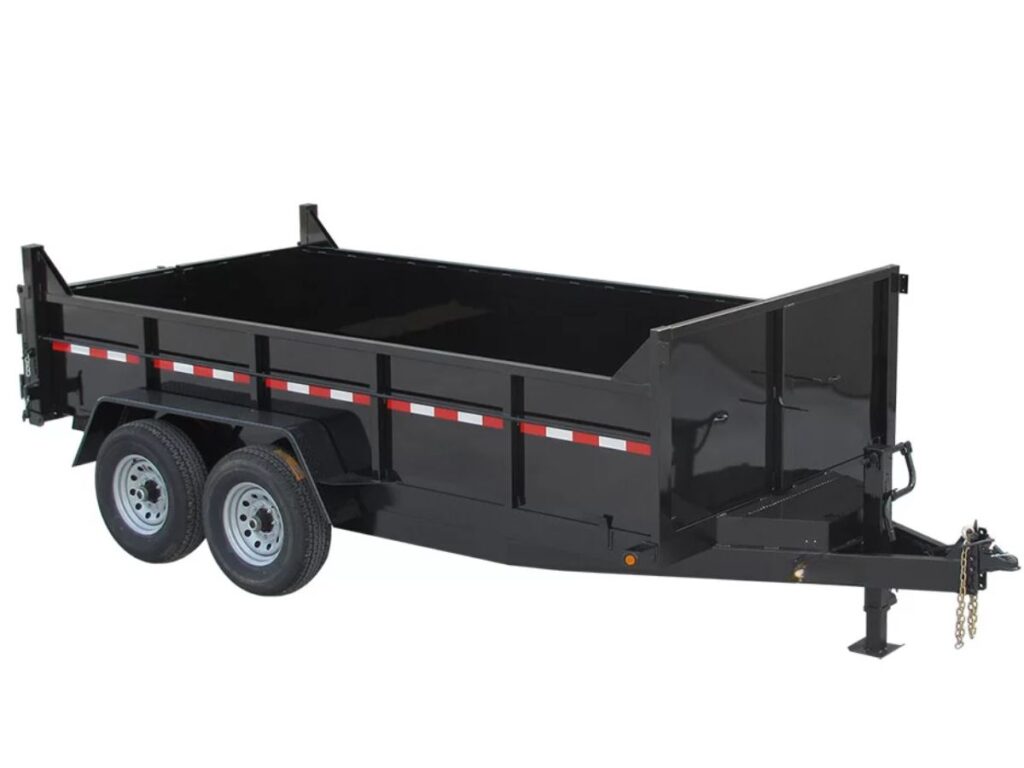
9. Enclosed Trailers
Enclosed trailers offer protection that open trailers can’t.
These trailers have solid walls, a roof, and a locking rear door. That makes them perfect for hauling items that need shelter from rain, dust, or theft. Some even come with side doors or built-in shelving for better storage.
They’re like a portable garage on wheels.
Key Features
- Fully Enclosed Body: Walls and a roof protect the cargo from weather and road debris.
- Locking Rear Door: Keeps items secure during transport and when parked.
- Side Door Access: Some models include a side entry for easy access without unloading everything.
- Interior Tie-Downs: Helps secure boxes, tools, or gear inside.
- Custom Options: Many include shelves, vents, or lighting for specific needs.
Best Used For
- Moving Furniture and Boxes: Keeps household items clean and dry.
- Tool and Equipment Storage: Great for contractors needing mobile workstations.
- Vending and Merch Setup: Perfect for traveling sellers or musicians.
- Motorcycles and ATVs: Offers protection during long-distance transport.
Pros and Cons
Pros:
- Complete weather and theft protection
- Keeps cargo organized and secure
- Versatile for business or personal use
Cons:
- Heavier than open trailers
- Costs more upfront
- Limited height for loading tall equipment
If the load needs to stay dry, clean, and out of sight, an enclosed trailer is one of the smartest choices out there. I’ve seen it protect everything from delicate sound equipment to power tools and family furniture—especially during long hauls or bad weather. When things go wrong on the road, having a locked, sealed trailer gives peace of mind you can’t put a price on.
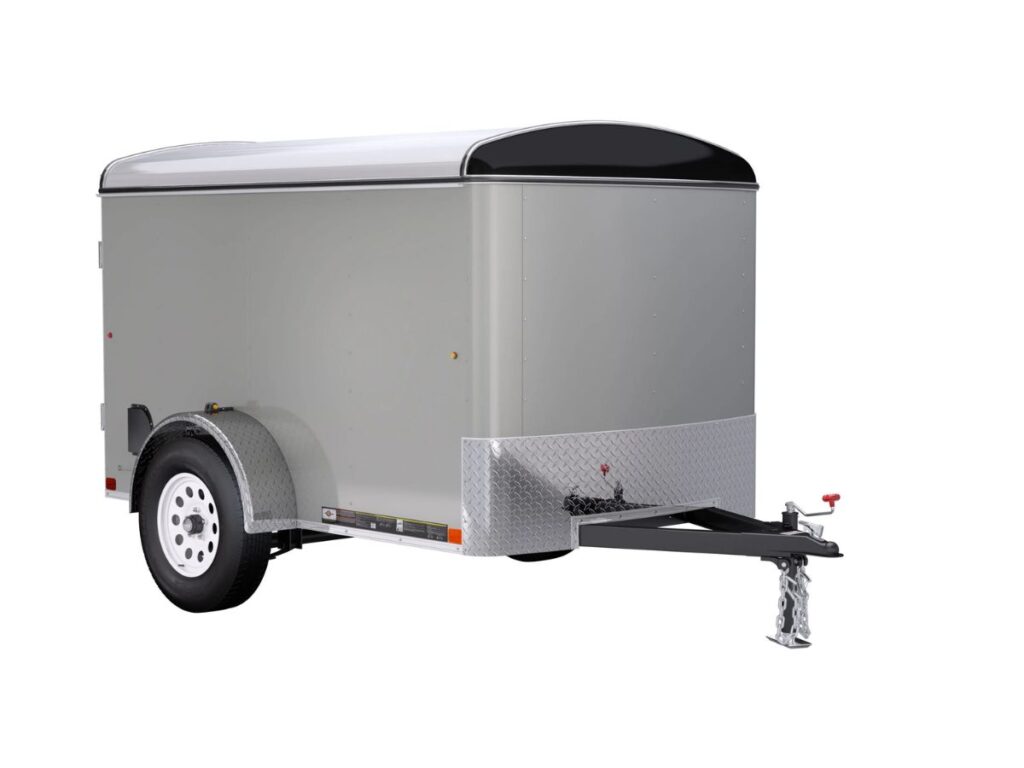
10. Dry Van Trailers
Dry van trailers are the big box trailers you often see on highways. These trailers are simple, sealed, and made to move general cargo.
They’re fully enclosed but don’t have a cooling system like a refrigerated trailer. That means they’re best for dry goods—things that don’t need temperature control but still need to be protected from rain, dust, or theft.
They’re one of the most common trailers in logistics for a reason.
Key Features
- Fully Enclosed Box: Protects cargo from outside elements like weather and road grime.
- Standard Sizes (48–53 ft): Gives plenty of room for boxed or palletized freight.
- Swing Rear Doors: Allows fast loading and unloading at docks.
- Wood or Aluminum Floor: Strong enough to hold heavy pallets and forklifts.
- No Temperature Control: Not designed for frozen or heat-sensitive items.
Best Used For
- Packaged Consumer Goods: Great for non-perishable food, cleaning products, or bottled drinks.
- Retail Shipments: Moves boxes and pallets from warehouses to stores.
- E-commerce Orders: Carries items from fulfillment centers to delivery hubs.
- Electronics and Furniture: Provides dry, secure transport for large items.
Pros and Cons
Pros:
- Protects goods from weather and theft
- Easy to load at loading docks
- Widely available across shipping fleets
Cons:
- No cooling or ventilation
- Not suited for perishable or sensitive cargo
- Can be noisy or hot inside during summer months
If the cargo doesn’t need cold air but still needs to arrive clean, dry, and secure, dry van trailers are a go-to choice for good reason.
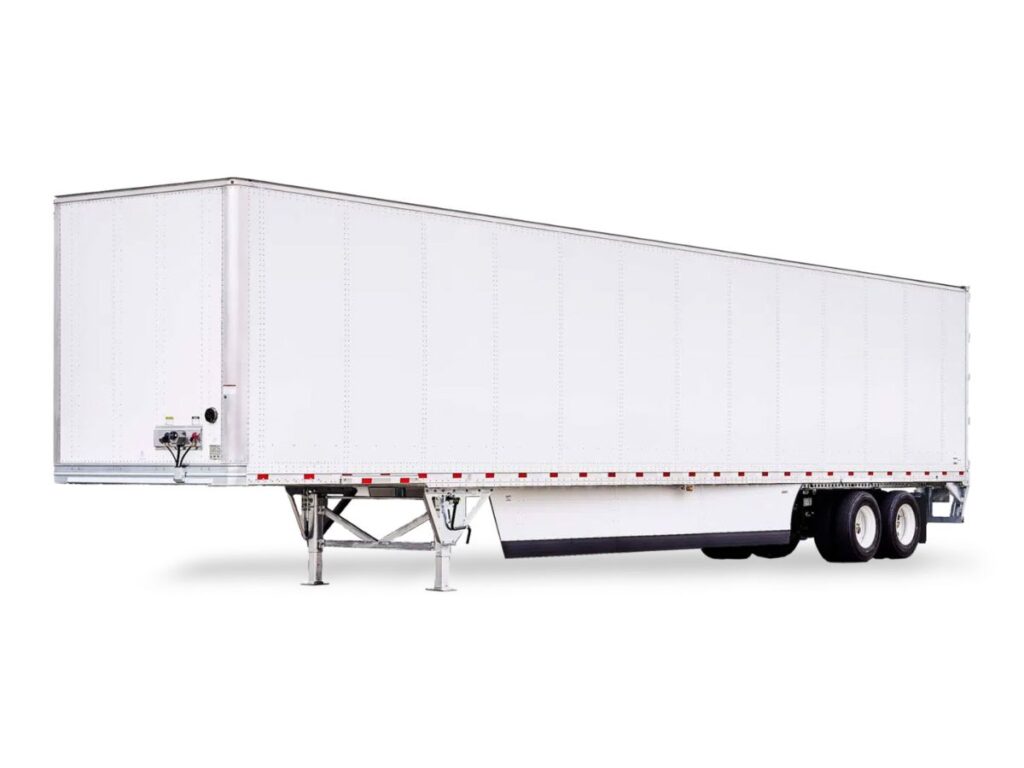
11. Lowbed Trailers
Lowbed trailers, also called lowboy trailers, are made for hauling tall and heavy equipment. I’ve spoken with heavy-haul drivers who specifically use Rhinotrail lowbed trailers—they say it’s the only trailer they trust for moving big machines. Because these trailers sit very close to the ground, they can carry tall loads while staying within legal height limits.
Key Features
- Dropped Deck Design: The center of the trailer sits lower than normal, allowing extra height for tall cargo.
- High Weight Capacity: Built with strong steel frames and multiple axles for heavy machinery.
- Detachable Gooseneck (on some models): Makes loading equipment easier by removing the front section.
- Multiple Axle Options: Helps spread the weight of oversized loads across more wheels.
- Low Ground Clearance: Keeps the load stable and helps avoid height restrictions on bridges or roads.
Best Used For
- Bulldozers and Cranes: Carries oversized machines that can’t ride on standard trailers.
- Large Tanks or Pipes: Supports tall or wide industrial gear.
- Construction and Mining Equipment: Moves gear too big for flatbeds or drop decks.
- Generators and Transformers: Handles dense, heavy loads safely.
Pros and Cons
Pros:
- Allows taller loads without special permits in some cases
- Strong enough for very heavy cargo
- Easier to load equipment from ground level
Cons:
- Expensive to rent or own
- Heavier, which affects fuel use
- Needs proper planning for routes and permits
For massive, oversized hauls, lowbed trailers are built to take the pressure—one load at a time.
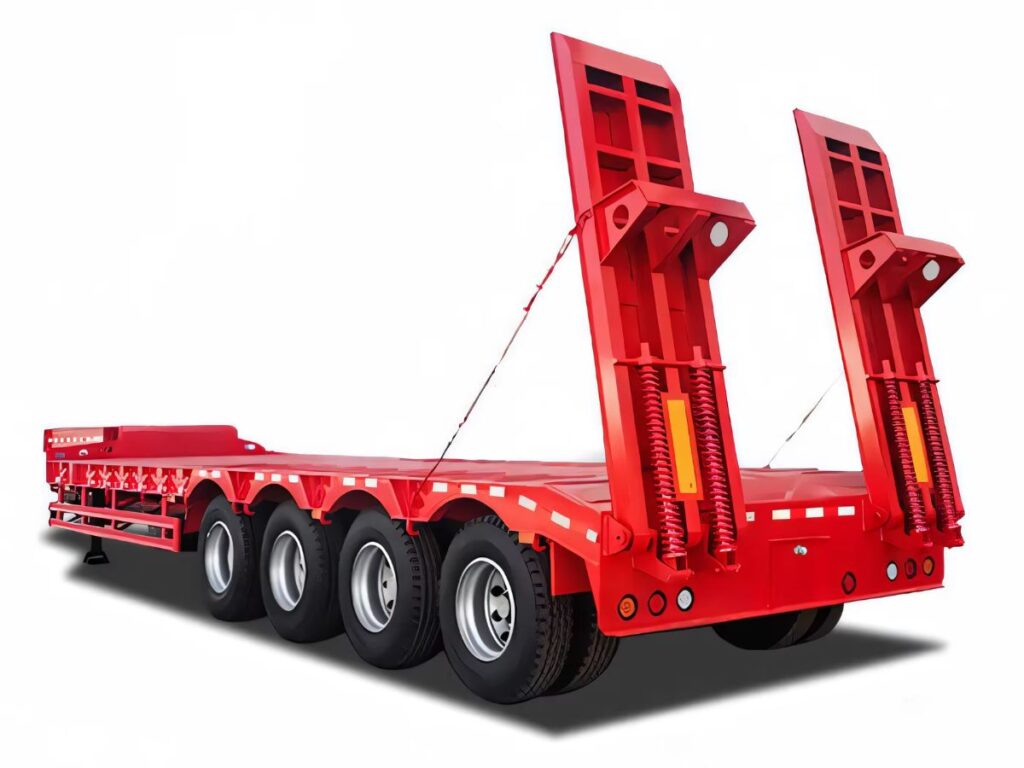
Conclusion
I still think about that load I lost years ago—torn tarp, scattered gear, a hard lesson. But it’s what led me here.
You now know 11 cargo trailer types. What they do. Where they shine. What to avoid.
This guide gives you a clear starting point. No more second-guessing.
Start now. Own the load, don’t let it own you.
Have questions about which trailer fits your job?
Rhinotrail is here to help.
Contact us today and we’ll help match you with the right trailer—built to work as hard as you do.


